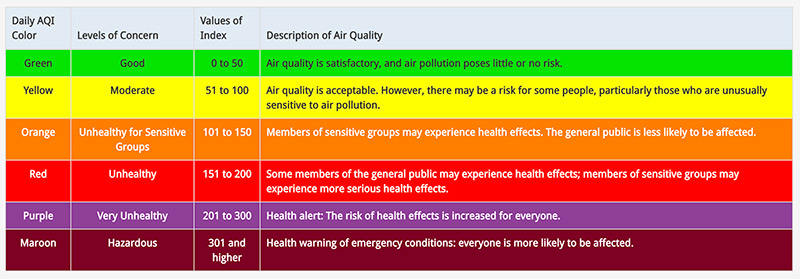Why Is Air Quality Worse During The Summer?
The summer months bring the return of heat and humidity to many parts of the country, which can result in poor air quality that can affect breathing and oxygen intake. Prolonged exposure to poor air quality can cause difficulty breathing and issues with the respiratory system especially with older adults, people who work or exercise outdoors during the summer, those who travel long distances and more.
This is especially important because the air we breathe contains only 21% oxygen, and our body needs oxygen to fuel our cells, create new cells to replace old cells, create energy from nutrients during food digestion and to help our tissues and organs function properly. Poor air quality can limit the amount of quality oxygen in the air we breathe, making us fatigued, short of breath and possibly sick.

Why is air quality worse during the summer? – Think of the atmosphere around you as a giant oven. During the summer months the heat and radiation in the sunlight essentially cook the air, creating a chemical soup (primarily ozone) which combines with other pollutants, pollen and mold to create poor air quality.
How is air quality measured? – The Environmental Protection Agency uses the “Air Quality Index” or (AQI) to measure air quality and pollution in the air.
What are the symptoms of unhealthy air quality? – Poor air quality and polluted air can cause difficulty breathing or other lung problems in healthy people, older adults or those with preexisting respiratory conditions like asthma or COPD.
What locations have the worst air quality? – The American Lung Association publishes an annual “State Of The Air” report on states and cities with the worst air quality. Among the worst ranked are states you might suspect such as California and Texas. But there are also some you might not expect such as Washington State, Oregon and Pennsylvania.
How to breathe easier during the summer months – There are a few things you can do to help yourself breathe easier during the summer months. Avoid going out during heat spells or during the hottest times of the day, plan activities for morning or night, find a good source for weather and air forecasts, and use supplemental oxygen in case you experience breathing issues from poor air quality.
Why Is Air Quality Worse During The Summer?
The heat and humidity of the summer can result in poor air quality, both outdoors AND indoors. Sunlight and solar radiation can produce more ozone in the air we breathe, which is dangerous. Pollution like nitrogen oxides react with other chemicals and hydrocarbons in the sunlight to form ozone gas. Ozone is good when it is high in the atmosphere because it blocks the harmful effects of the sun. However, ozone gas is bad at ground level as it is a toxic gas to breathe and can cause respiratory problems. High ozone levels also increase the rate of other air pollutants in the stagnant air during the summer, especially in large cities with higher concentration of nitrogen oxides. Warmer weather also means more travel, which can increase air pollution levels dramatically. All of this creates a chemical soup in the stagnant and hot summer air that can cause breathing problems. As your body heats up and you inhale this air, your lungs have to work extra hard to keep your body properly oxygenated.
How Is Air Quality Measured?
The Environmental Protection Agency uses the “Air Quality Index” or (AQI) to measure air quality and pollution in the air. It measures levels of carbon monoxide, nitrogen dioxide, ozone and sulfur dioxide in the air, as well as the estimated concentration of “particle pollution” (also known as “particulate matter”). The AQI is like a scale that measures from 0 to 500. The higher the value, the greater the level of air pollution. An AQI value of 50 or below is good air quality, while anything over 300 is hazardous quality. For more information on the AQI visit this link from AIRNOW.gov or see the graphic below:

What Locations Have The Worst Air Quality?
The American Lung Association publishes an annual “State Of The Air” report on states and cities with the worst air quality. You can view the latest findings here and view data by state, county and metro areas. Among the worst ranked are ones you might suspect such California and Texas. But there are also some you might not expect such as Washington State, Oregon and Pennsylvania. As you will see, these states have poor summer outdoor air quality for several different reasons based on region, industries in that region, pollution caused by travel issues, annual wildfires, summer activities and more.
Also, as many senior citizens can attest to the southeast and southwest regions of the country can be especially hot and humid during the summer, making it difficult to breathe – especially for those with preexisting medical conditions.
Keep in mind the levels of indoor air pollutants are often 2 to 5 times higher than outdoor levels, and in some cases these levels can exceed 100 times that of outdoor levels of the same pollutants. That means the indoor air quality can be even worse than outdoors during summer months! Among some of the worst summer indoor air quality locations are bus stations, schools, warehouses and manufacturing facilities – especially for workers who spend the majority of their days inside those locations.
How To Breathe Easier During The Summer Months
If you are someone who experiences breathing issues from poor air quality during the summer, try to plan your daily outdoor activities during the morning or evening hours when the heat and humidity is generally at its lowest. You can also plan ahead by using an online resource to check the air quality in your area. A good resource to use is AIRNOW.gov, a website run by the EPA that provides daily updated and easy to understand air quality information about your area including current air quality, forecasts and important air quality announcements.
In addition, you can also fight the symptoms of poor air quality by using portable supplemental oxygen like Boost Oxygen. Boost Oxygen is pure oxygen in affordable and convenient canisters. It’s portable “oxygen to go” for recovery from shortness of breath in the heat and humidity of the stagnant and sometimes polluted air. Boost Oxygen is perfect for places or activities you might need pure oxygen including the beach, camping, exercise like outdoor running, hiking or biking and sports like basketball and tennis.
*Disclaimer: 95% Pure Boost Oxygen is for recreational purposes only, ideal for athletes and sports enthusiasts, older adults, and people at high altitude or in poor air quality. No prescription is needed to purchase Boost Oxygen. As it is not medical-grade oxygen, not a drug, and not intended for the treatment of any medical condition or disease, it is neither regulated nor approved by the FDA and thus the Agency has not assessed any of the statements herein. Consult your physician if you have any medical conditions.













